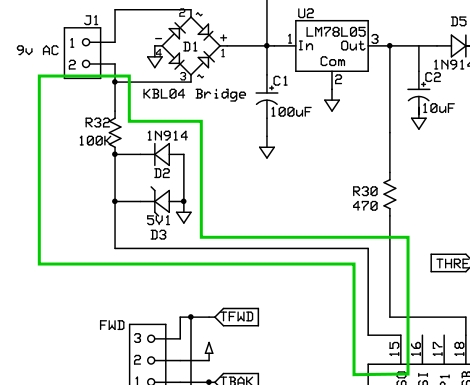Hackaday writer of yore [Will O’Brien] has been working on this hardware for his motorcycle. Speed, voltage, gear, and temperature data is displayed on a 16×2 character LCD. The speed is pulled from the bike itself and the gear is calculated by comparing engine RPM to wheel RPM. He’s using the popular DS1820 1-wire temp sensor along with an Arduino to pull everything together. At this point he estimates there’s about $50 worth of parts, but that can be reduced by etching a board and just using the necessary components.
Author: Mike Szczys6403 Articles
Adding Reset To An FTDI Cable

Hackaday alum [Adam Harris] hacked an FTDI cable to use for programming his Arduino. After cracking open the plastic case he found the FTDI chip used is the same as the one in the SparkFun programmer. The only real difference was that his cable wasn’t resetting the Arduino, he had to do that manually. The solution was to reroute the RTS wire so that it connected up to the DTR pin. This proved difficult because of the tiny footprint of the chip, but after many tries he managed to get a piece of wire wrap soldered in place.
Using A/C Frequency As A Clock Signal
A while back we saw a logic clock that used the alternating current frequency from the power grid to keep time. We asked for information on your projects that use this method and we got a lot of comments and tips. Today we’re sharing [Doug Jackson’s] method which he used in his word clock.
The schematic above is from that project and we’ve outlined the important part in green. [Doug] pulls a signal from the 9V AC power before it hits the bridge rectifier, using a 100K resistor and a zener diode to protect the microcontroller pin. The code for that project comes as a hex file but he sent us the C code pertaining to this timing circuit. It’s written for PIC but you’ll have no trouble adapting it to other microcontroller families. Take a look after the break.
Optiboot Makes Your Arduino Faster, Sleeker

Tired of waiting for that Arduino sketch to upload? Find yourself limited by code space? Optiboot eases both of these problems. The package is an alternative bootloader that runs at a higher baud rate (115200 versus 57600) and it takes up 1.5 KB less space than the stock version. This means your sketches can be larger without upgrading to a beefier chip and they will take less time to upload, a lot less.
This fully compatible alternative to the Arduino bootloader requires an AVR ISP programmer to burn it to the chip on your Arduino. If you have an extra AVR lying around you could use the Arduino as a programmer and then physically swap the chips.
[Thanks Peter]
Sony Removes PS3 Linux Support; Gets Sued For It

On April first Sony rolled out new firmware for the PlayStation 3 that removed the ability to install Linux on the system by blocking a feature called OtherOS. Now a class action lawsuit has been filed against the company for its actions. It doesn’t take an attorney to figure out that they removed features that were a major selling point for the system. As mentioned in our previous article, the ability to use an exploit to access the hardware doesn’t mean that every user installing Linux on the system plans to do so. The suit asserts that users had no opportunity to negotiate the System Software Licensing Agreement which is only presented to a purchase after the sale is made. The lawsuit is availble in PDF from from IGN.
Who knows where this one will end up. The suit seeks an injunction against the removal of the OtherOS feature as well as compensatory damages. No matter what happens, we still think the removal was a bad move on Sony’s part.
[Thanks Shueddue]
Hacking Game Boy For Sound
[Gijs] cracked open his Game Boy and added some parts to give him more sound synthesis control. He uses Little Sound Dj (LSDj), a popular Game Boy program used to pump out those classic 8-bit sounds. The unit seen above and heard in the clip after the break has an added potentiometer and circuit board. He’s got a few other hacked Game Boys on his site as well, including an Arduino generating random music on the handheld.
Mindstorm Rubik’s Solver
It has been quite a while since we looked in on the world of automated Rubik’s cube solving. [David Gilday] built this one using LEGO Mindstorm parts. It uses a computer to calculate the solutions but unlike the standalone Tilted Twister, this creation can solve more than one type of cube. As long as the physical dimensions are between 5 and 6 centimeters on a side, the machine can solve 2, 3, 4, and 5 piece cubes. [David] wasn’t quite satisfied with that though. He built a separate machine to take care of the 6x6x6 cubes too. See both in action after the break.
Want to see more? Don’t miss the CuBear solver developed at Berkeley or the AVR based solver.














